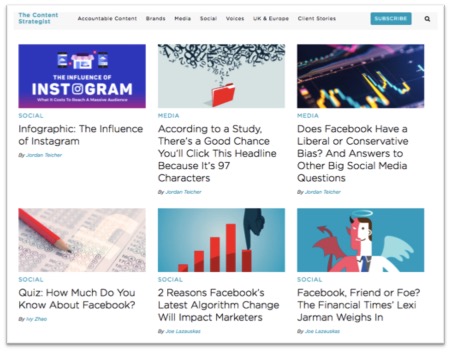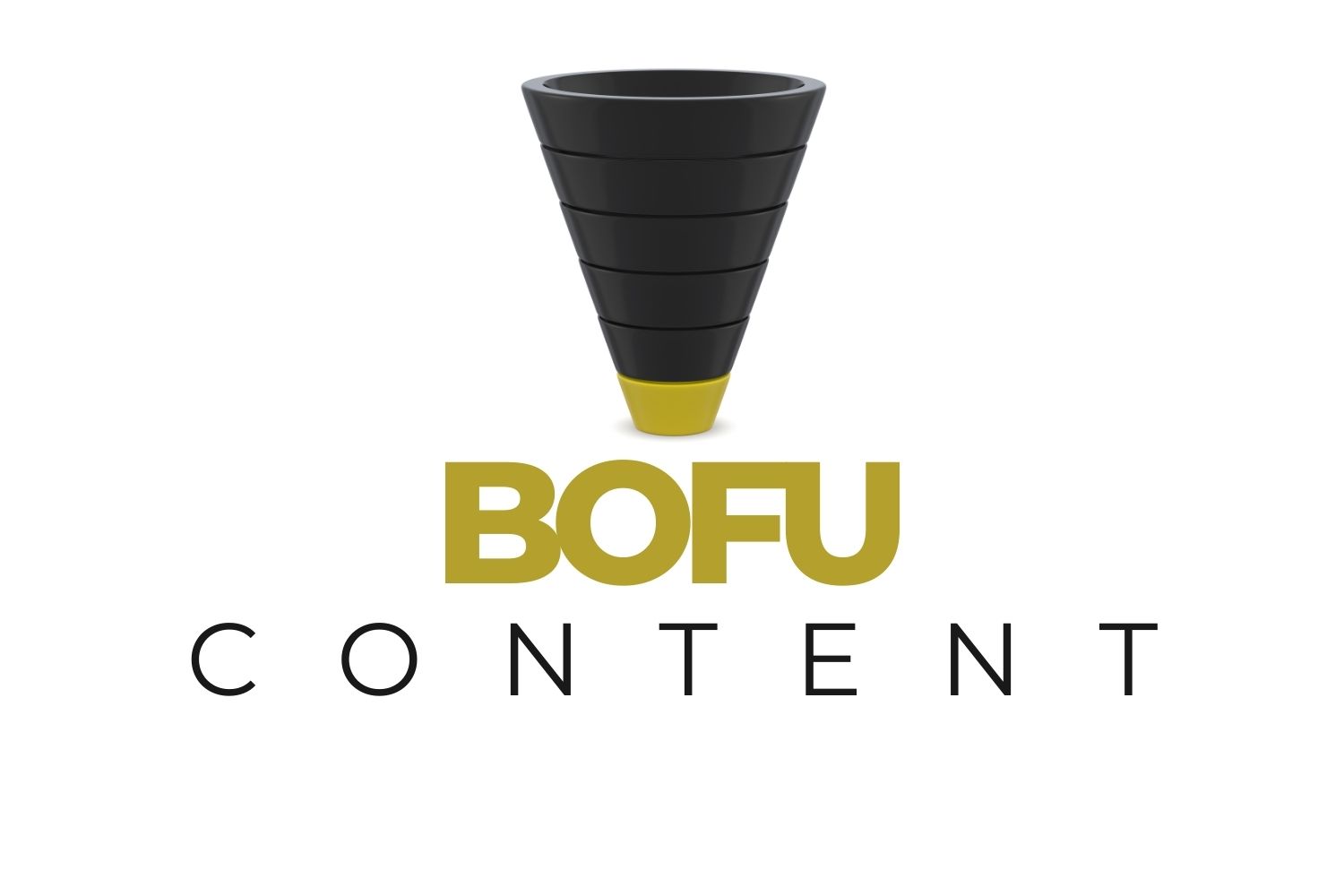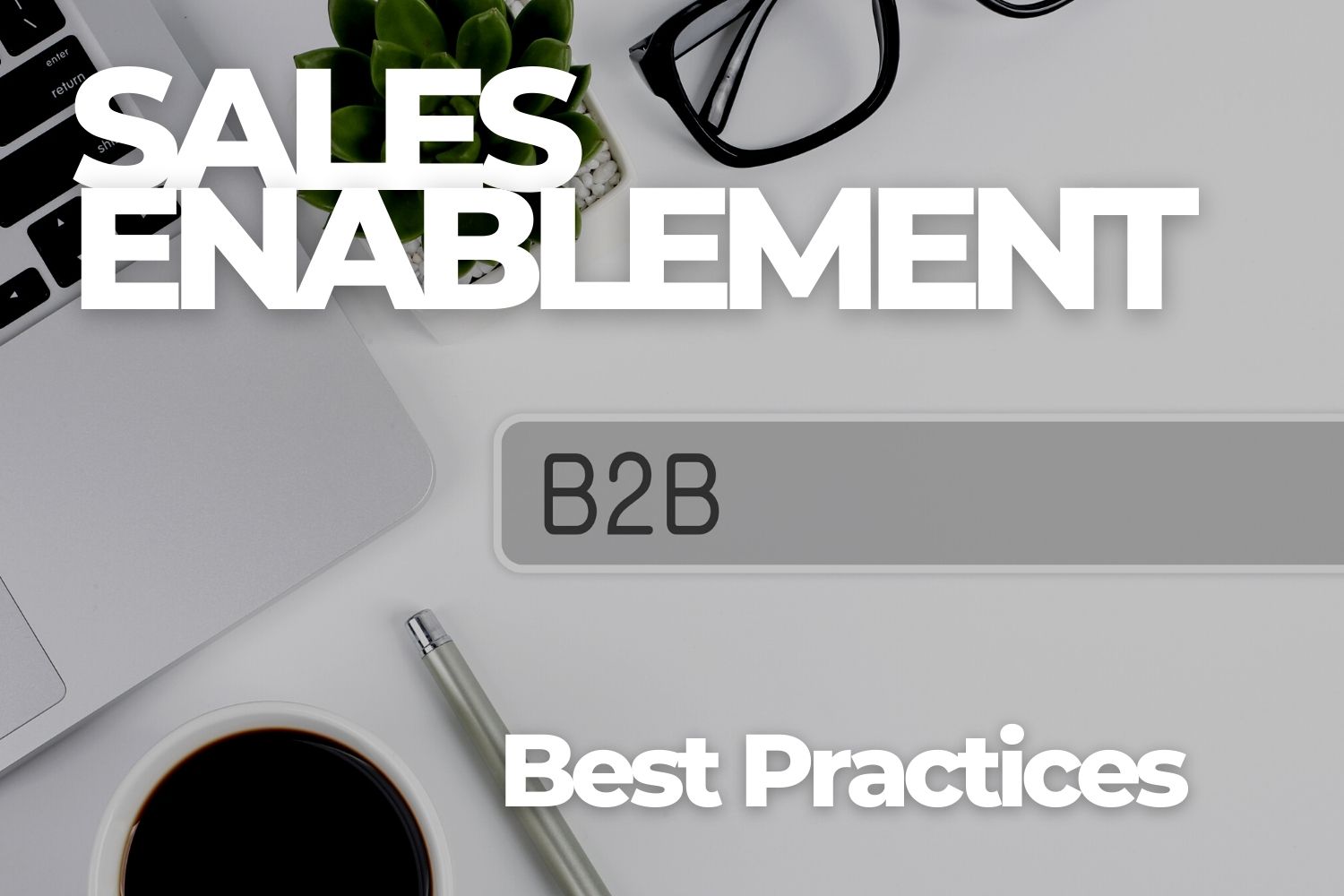I did a search for “SaaS content marketing.” Perhaps doing the same got you here.
Interestingly, I found some good (though predictable) write-ups of some of the better content marketing efforts from SaaS companies, but no article showcased them the way I’m about to.
In addition to telling you about the many shining examples of SaaS content marketing I’ve rounded-up, I’m going to give you a look at each program and hone-in on the strategy at work.
Of course, I’ll include blogs and some unique content from them, but my goal is to feature some impressive content ideas that are bigger than blogs because I want you to think beyond the blog.
“Almost all big, successful SaaS companies use content marketing. Most of them don’t understand it, and don’t execute it properly.”
(The State of SaaS Content Marketing, cobloom report, 2017)
Microsite — CoSchedule
If you pay close attention the way I do to how SaaS businesses in the marketing tech sector strive to deliver the most strategic and helpful content, you simply can’t miss CoSchedule.
The bar there is supremely high. If you want to achieve “10X content” (nod to Rand Fishkin), do what CoSchedule does. Of course, doing so requires serious resources.
This recent example, The Ultimate Guide to Create a Marketing Strategy, is off-the-charts.
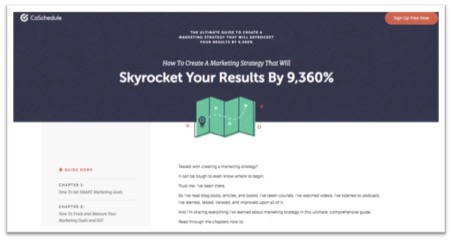
CoSchedule’s robust microsite is a detailed 10-chapter strategy planner. To help make your experience productive, CoSchedule includes a downloadable Marketing Strategy Template Kit featuring a PowerPoint deck and spreadsheet.
Bonus pro hat tip
Great headline: “How to Create a Marketing Strategy that will Skyrocket Your Results by 9,360%.”
CoSchedule’s marketing mastermind Nathan Ellering once told me his company’s testing proven headlines structured with “How to (Do Something) ‘that will’ (Produce a Specific Positive Result)” perform remarkably well.
Content site — Adobe CMO.com
Some companies—not many, mind you—take content marketing so seriously they go so far as to adopt a strict publishing paradigm. They create an online publication and/or magazine—separate from their original branded website—different name and all.
I don’t know of many, but don’t take that to mean I recommend your SaaS brand employs this ambitious approach. You have to commit to assembling a vast and talented workforce entirely focused on publishing industry specific news and content for the long haul.

CMO.com is “by Adobe” (look closely). Visit the site if you never have and you’ll immediately appreciate how serious Adobe is about satisfying the informational needs of CMOs with features, interviews, opinion, Adobe Digital Insights (research), and more.
A community site— ZenDesk
“Relate is home to a diverse selection of expert content from ZenDesk,” says ZenDesk. “It helps you examine, ponder, and hopefully improve the interactions you have with other people whether they’re customers or coworkers, friends or frenemies. Cool.
I must admit I struggled with how to categorize this stellar site. Like the CMO.com site, we’re looking at a company sponsored website. However, Relate not only offers heaps of content—original and curated—but focuses in large part on ZenDesk events of the same name.
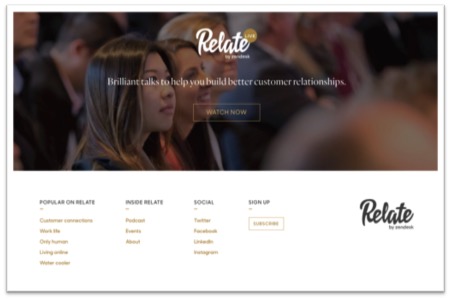
Click the link above and you’re led to “Relate Live Global,” an online conference about building better customer relationships.
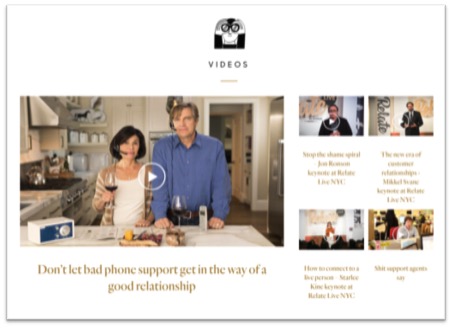
The Relate site offers multiple content formats and is organized by them, including: posts, podcasts, videos (shown above), curated, acumen, and paper. You may have to check it out to make sense of some of that stuff, but trust me; this is a gargantuan content effort.
Answers section — BigCommerce
A recent opportunity to write for BigCommerce inspired me to learn more about their area of expertise: ecommerce software. Look what I found when I went hunting for answers…

I found Ecommerce Answers, an entire section of the BigCommerce website dedicated to answering every conceivable question. The questions are organized in eight easy-to-navigate sections. A glossary is offered too.
Each Q&A invokes its own page intentionally optimized to appear in search results when the topic is researched. It’s obvious why I found it, why thousands of ecommerce companies will as well, and thus, why this strategy is so smart.
Customer showcase — Kajabi
I raved about this awesome content initiative when I wrote a post about user-generated content ideas. #KajabiHero is a customer showcase, a series of case studies. It’s certainly not a content feature you haven’t seen before, however, they pull it off with some amazing panache and unique ideas.
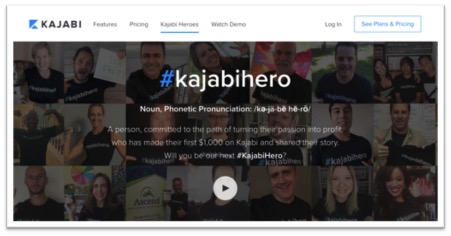
Kajabi kicks off its “Hero” section with a fun video montage. What follows is a feature story of its newest hero. Then, a massive collection of customers is presented. They’re filterable by 18 distinct categories.
What I find crazy clever is when you choose to learn more about a specific #KajabiHero, you’re not sent to a Kajabi post or page, but to the client’s website. The genius lies within because the client’s website is built on the Kajabi knowledge commerce platform.
I suspect this strategy makes it remarkably simple to convince users to join the club.
Resource library — GetResponse
Strong content marketers often place the word “resources” in their menu bar and guide visitors to a library of helpful content. I’ve found some, but not many, SaaS marketers employ the approach, gate all or much of the content, and use their lead magnets to grow email lists.

GetResponse is one such SaaS company that offers a deep, impressive resource library. Check out that fun and inspiring subtitle above. I’ve written a few of the eBooks featured on this impressive content hub including the “Getting Started Tips” guide you see above.
Bonus pro hat tip
GetResponse created its marketing automation hub less than two years ago and hired many experts to “stock the shelves.” Look how the company has created a menu to help you find the type of content you seek—among 12 categories. Impressive.
Content showcase — Playbuzz
Don’t confuse Playbuzz with Buzzfeed. Playbuzz is a SaaS company publishers and brands use to create interactive content.

While the Playbuzz playbook looks to be expanding, the company’s bread is buttered mostly by customers looking to create quizzes. As such, a section of the website is a customer showcase, which is updated every time a customer chooses to take advantage of the option to appear here.
Um… though two of the four quizzes shown above are about murder, it’s just a crazy coincidence. Killer idea they have here though. (I couldn’t resist.)
Awards — Kapost
Kapost has a blog. They also have a robust resources section. I’ve got the call to pen several posts and eBooks for them. These content approaches do pretty well.
But the thing I want to focus on, the Kapost 50—an annual awards showcase—is the true ace of spades in their content marketing deck.

Kapost competes with various SaaS companies in the enterprise B2B content marketing platform space, but stands alone with their awards program. Each year, they evaluate hundreds of B2B brands and recognize 50 they deem to be the best and give each one a showcase page with a summary, a sample of “winning content” and a link to their website.
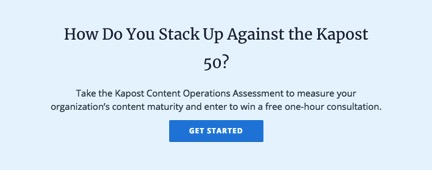
Bonus pro hat tip
The page where the 50 winners are honored offers a smart CTA: the Kapost Content Operations Assessment, which it says measures your content maturity. The page also archives each year’s winners since 2012.
Research report — Buzzsumo and Moz
Buzzsumo knows how to get shares and links. Moz too. When the two SaaS companies combined forces to analyze the shares and of more than a million articles, their findings included:
“There are specific content types that do have a strong positive correlation of shares and links. This includes research backed content and opinion forming journalism. We found these content formats achieve both higher shares and significantly more links.”

They created a sumo-sized piece of research and ran with it, offering detailed posts on both of their blogs, as well as landing pages to download the report.
The results? The research was cited and quoted often in a ton of posts, and of course, earned immense shares and links. The research was also repurposed in a variety of ways.
The lesson? Research rocks search and social. Find a way to produce timely research in your niche and you’re likely to enjoy similar results.
Videos — Vidyard
I’m not going to tell you Vidyard stands alone by offering a healthy heap of videos as a content marketing strategy. I will tell you they’ve been doing it for a long time and do it better than most.
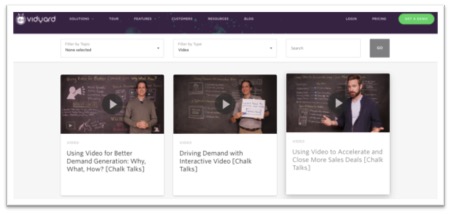
Vidyard is in the video business, so you’d expect good things from them with the web’s fastest rising content format. They don’t disappoint. Among the many video treats offered via the Vidyard resources section is the tidy Chalk Talks series: 10-ish minute lessons on specific video marketing tactics.
Podcasting — Rainmaker.fm
While the video format is used in a great deal of SaaS content marketing programs, podcasting is not. An interesting research report from Cobloom, The State of SaaS Content Marketing, reports only 18% of the 250 biggest SaaS companies have their own podcast.
Cabloom says SaaS marketers should watch this space because there are now more podcast listeners than Catholics in the U.S. Have mercy.
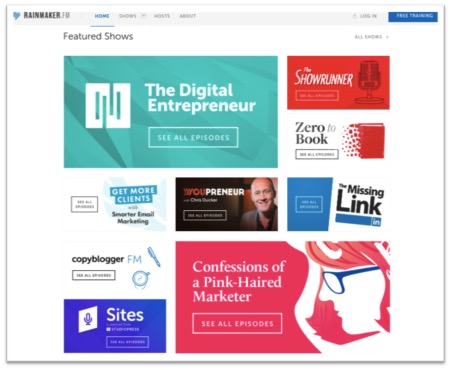
This is Rainmaker.fm.
I should note, Rainmaker was a SaaS platform, a robust digital marketing platform from Copyblogger. Now it’s more. In 2017, the company evolved to a hybrid tech and services model.
In any case, I had to showcase Rainmaker.fm to show you a SaaS brand that not only went into podcasting as a content marketing strategy, but also did so by creating NINE podcast programs. The attractive grid on the website shown above serves as a program guide though each program also stands on its own.
It’s a radio network, web style.
Webinars — Kissmetrics
Here again, we’re not looking at an unusual strategy, but a SaaS company that pursues a smart marketing strategy—webinars—unusually well.
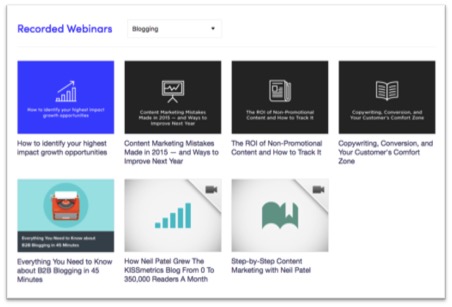
Kissmetrics does a webinar each week. All of them are archived on a section of their site, which you can sort by category. Nearly all the webinars feature guest experts, so their strategy also serves to widen their net of influencers and promoters.
I know how much planning and promotion goes into the Kissmetrics series because I’ve joined them twice (the webinar top-right above featured me).

Bonus pro hat tip
The Kissmetrics webinars are very well attended as they are promoted via email and on an ongoing basis on their popular blog (as shown in the sample above).
Refreshingly, the webinars are not infomercials. While each focuses on delivering helpful marketing tips, you can stick around for a 5-minute product demonstration that follows the Q&A sessions at the end, if interested.
Templates — HubSpot
When it comes to SaaS content marketing strategies, HubSpot covers nearly every base. Being the pioneer of inbound marketing, they also teach many of the tactics we’re covering here today (though not with a focus on SaaS marketing). They’re also one of the premiere SaaS companies—especially in the world of marketing technology.
I went hunting for something HubSpot does that stands out. I found more than one example, but chose to showcase this, a section of their site offering “free templates.”
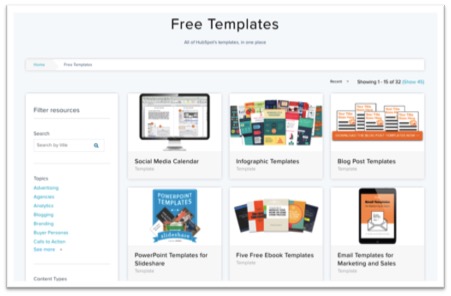
Whatcha’ need? It appears if HubSpot can help you by providing free templates they will. I suspect many prospects and customers find them valuable. The screenshot here shows six categories, but there are actually 45. That’s not a typo. 45.
If you like the idea of offering templates, perhaps what you have here is a template for doing so.
Events — Box
Box is another SaaS company firing on all cylinders with a well-stocked resources section to meet the needs of prospects, customers and partners. I found what they’re doing on the events page within their resources section interesting.
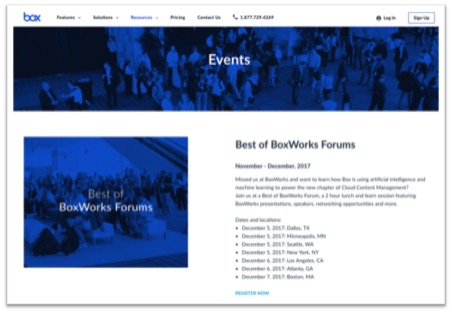
BoxWorks is a 3-day event. Obviously, they want you to attend. But if you didn’t they take the show on the road to provide helpful (and free) content. It appears they hit 8 big cities in a 3-day span with a lunch-and-learn event they call “Best of Box Forums.”
On the same page where you can book your spot, you’re also offered a consolidated, half-day, virtual version of the conference you missed and a preview of the next one.
Free tools — Agorapulse
You’ll find a “Free tool” tab in the Agorapulse.com website. And within it you’ll find three helpful freebies.
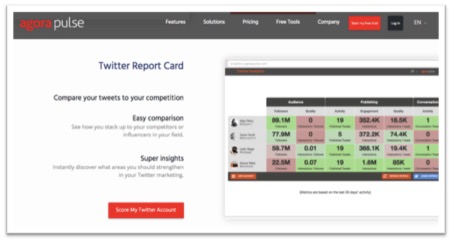
One of the free offerings is the Twitter Report Card. The teaser copy reads, “With just a few clicks, discover how your Twitter efforts compare to your closest competitors.”
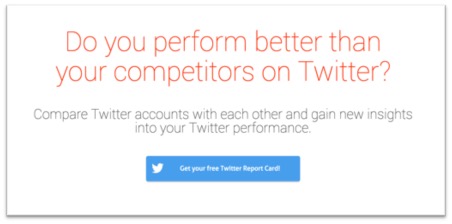
Bonus pro hat tip
Look at that great headline. You must learn the answer, right? Hat tip #2, the free tools Agorapulse offers are perfectly aligned with the brand’s value proposition.
Onsite training course — Ahrefs
SaaS companies often sell robust or complex tools that take time and effort to master. As such, offering an in-depth training course can be a smart way to win and retain customers.
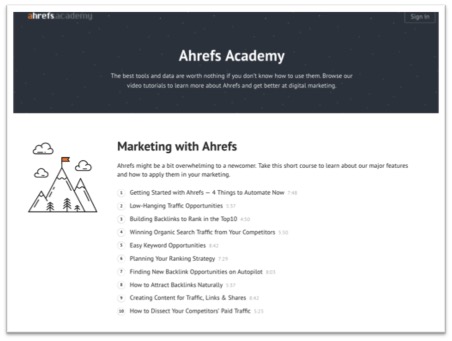
Ahrefs Academy looks thoughtful, thorough, and perhaps most importantly, not overwhelming. You can learn how to use their search marketing solution by taking in a 10-pack of videos. Each is less than 10 minutes in length.
Offsite training course — MailChimp
You may have noticed a lot of savvy marketers, including SaaS marketers, take some of their content to content hubs they don’t own or operate.
YouTube is an obvious example, but Amazon is the best example of what I’m talking about because though most Amazon properties are not free, they very well can be. So, essentially, you can use the insanely popular shopping site as a content hub. Search for information assets there and you’ll find an incredible amount of freebies.

Now, examples include online learning sites. MailChimp has created a robust library of training courses and makes them available to a large audience of online learners via Skillshare.
Workshop — Canva
This next idea features training courses too, but includes a cool and clever spin.
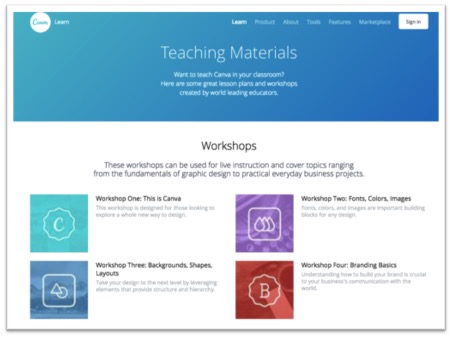
I should begin by saying Canva offers amazing content of the educational variety including a blog positioned as a design school featuring articles, tutorials and tips.
However, this content marketing play—Teaching Materials—is a bit different. It’s not for online do-it-yourselfers. It’s actually for teachers. And the workshops “store” is stocked with content created by teachers.
The page says, “These workshops can be used for live instruction and cover topics ranging from the fundamentals of graphic design to practical everyday business projects.”
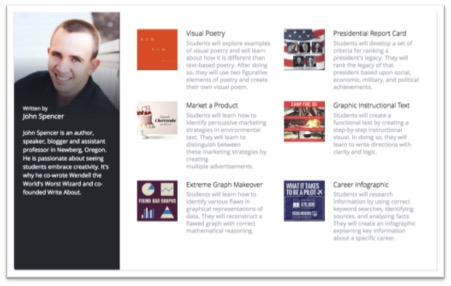
The rest of the page, or microsite, is populated with lesson plans (including the example above). There are currently 7 lesson plans, created by teachers, for teachers. It’s impressive.
Blog — Contently
I didn’t want to exclude blogs as an example of remarkable SaaS content marketing initiatives, but I didn’t want to focus on them either. Truth be told, the blog has become table stakes for content marketers. The secret to business blogging success is to consistently create great content.
Focus on quality over quantity. The occasional amazing post will earn you search visibility, traffic, social shares and subscribers far more effectively than a regular dose of short, lightweight stories.
Contenty publishes one of my favorite blogs and certainly one of the best in the SaaS business. I love how Contently’s The Content Strategist blog is organized into seven relevant categories, how it’s marketed via email, and of course, the consistently top-notch writing.
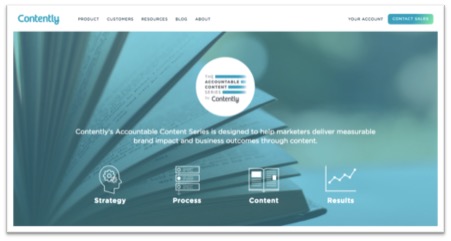
When you click into the blog’s first category, Accountable Content, you discover a micro-site or what’s sometimes called a content hub. A massive collection of articles dive deep into the topic and users can filter them to focus specifically on strategy, content, process and results.
Expert roundup — OptinMonster
It’s not surprising The Conversion Rate Optimization Blog, from OptinMonster, has more than 60,000 subscribers. Their team does great work organized neatly into seven categories.
A quick look at the articles featured in the sidebar under “Popular Posts” is a lesson in how to write compelling headlines.
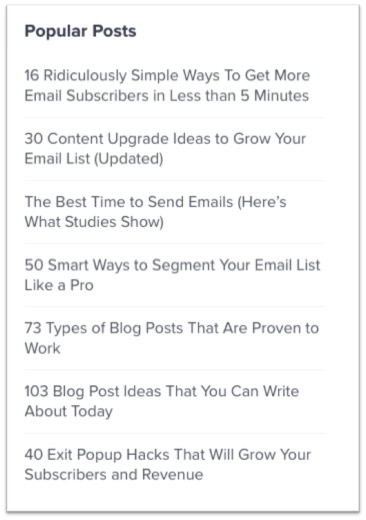
- Most are lists.
- Benefits are clear and specific.
- They use parenthetic statements (cleverly).
- Research is cited.
And…
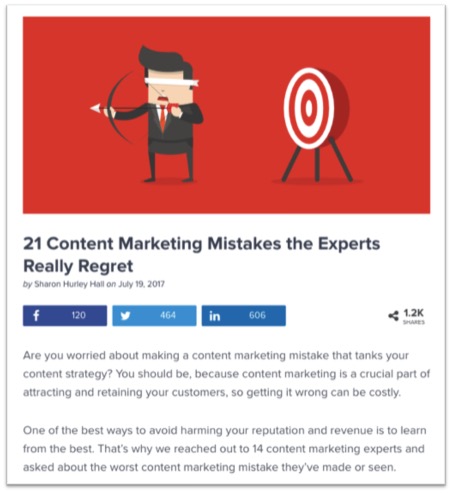
They often call on experts and create great roundups with the ideas they collect. I must admit, given the outrageous popularity of the roundup format, I don’t jump at every invitation to participate in roundups, but I do when Sharon Hurley Hall of OptInMonster comes calling.
The content marketing mistakes post featured above is a stellar roundup I’m proud to be in. It has a compelling angle, features many great minds, and is shaped to tell a cool story,
Bonus pro hat tip
The roundup includes attractive share-worthy images (see the example below).
I call them “social media cards.”

News — Trello
In my opinion, blogs that focus on news and PR, which my friend Jay Baer calls, “episodic brochureware,” should be labeled as such.
News-focused blogs can be painfully dull. They might win search traffic, but they’re less likely to generate the results you seek. My take is news blogs are generally for existing customers far more so than prospective buyers.
Cobloom’s report (cited earlier) claims 24% of SaaS companies have an educational blog. 20% have a PR/News-focused blog. A mixed approach has been adopted by 45% of the companies in their study.

I love what Trello’s done with their news. Check out the menu bar. Trello wants their customers to have easy access to company news, but rather than simply “slipping it into” their blog, which is largely educational content, they wisely call-out a specific news section.
Yes, your SaaS blog is a practical forum for announcing product updates, accolades, new hires, or any type of story you believe readers may be interested in, but you’ll do yourself a favor by calling company news precisely what it is.



